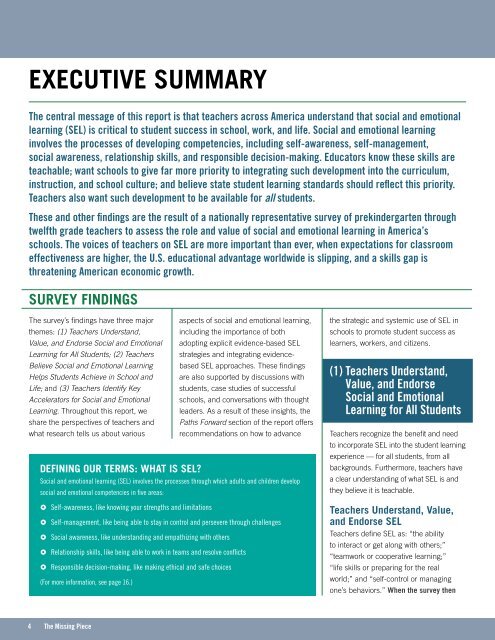CASEL-Report-low-res-FINAL
CASEL-Report-low-res-FINAL
CASEL-Report-low-res-FINAL
You also want an ePaper? Increase the reach of your titles
YUMPU automatically turns print PDFs into web optimized ePapers that Google loves.
EXECuTivE SuMMARy<br />
the central message of this report is that teachers across America understand that social and emotional<br />
learning (SEL) is critical to student success in school, work, and life. Social and emotional learning<br />
involves the processes of developing competencies, including self-awareness, self-management,<br />
social awareness, relationship skills, and <strong>res</strong>ponsible decision-making. Educators know these skills are<br />
teachable; want schools to give far more priority to integrating such development into the curriculum,<br />
instruction, and school culture; and believe state student learning standards should reflect this priority.<br />
teachers also want such development to be available for all students.<br />
these and other findings are the <strong>res</strong>ult of a nationally rep<strong>res</strong>entative survey of prekindergarten through<br />
twelfth grade teachers to assess the role and value of social and emotional learning in America’s<br />
schools. the voices of teachers on SEL are more important than ever, when expectations for classroom<br />
effectiveness are higher, the U.S. educational advantage worldwide is slipping, and a skills gap is<br />
threatening American economic growth.<br />
SuRvEy fiNdiNgS<br />
The survey’s findings have three major<br />
themes: (1) Teachers Understand,<br />
Value, and Endorse Social and Emotional<br />
Learning for All Students; (2) Teachers<br />
Believe Social and Emotional Learning<br />
Helps Students Achieve in School and<br />
Life; and (3) Teachers Identify Key<br />
Accelerators for Social and Emotional<br />
Learning. Throughout this report, we<br />
share the perspectives of teachers and<br />
what <strong>res</strong>earch tells us about various<br />
dEfiNiNg ouR TERMS: WHAT iS SEL?<br />
4 the Missing Piece<br />
aspects of social and emotional learning,<br />
including the importance of both<br />
adopting explicit evidence-based SEL<br />
strategies and integrating evidencebased<br />
SEL approaches. These findings<br />
are also supported by discussions with<br />
students, case studies of successful<br />
schools, and conversations with thought<br />
leaders. As a <strong>res</strong>ult of these insights, the<br />
Paths Forward section of the report offers<br />
recommendations on how to advance<br />
Social and emotional learning (SEL) involves the processes through which adults and children develop<br />
social and emotional competencies in five areas:<br />
Self-awareness, like knowing your strengths and limitations<br />
Self-management, like being able to stay in control and persevere through challenges<br />
Social awareness, like understanding and empathizing with others<br />
Relationship skills, like being able to work in teams and <strong>res</strong>olve conflicts<br />
Responsible decision-making, like making ethical and safe choices<br />
(For more information, see page 16.)<br />
the strategic and systemic use of SEL in<br />
schools to promote student success as<br />
learners, workers, and citizens.<br />
(1) teachers Understand,<br />
Value, and Endorse<br />
Social and Emotional<br />
Learning for All Students<br />
Teachers recognize the benefit and need<br />
to incorporate SEL into the student learning<br />
experience — for all students, from all<br />
backgrounds. Furthermore, teachers have<br />
a clear understanding of what SEL is and<br />
they believe it is teachable.<br />
Teachers understand, value,<br />
and Endorse SEL<br />
Teachers define SEL as: “the ability<br />
to interact or get along with others;”<br />
“teamwork or cooperative learning;”<br />
“life skills or preparing for the real<br />
world;” and “self-control or managing<br />
one’s behaviors.” When the survey then


